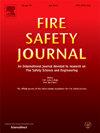Structural behaviour of tunnels exposed to fire using numerical modelling strategies
IF 3.4
3区 工程技术
Q2 ENGINEERING, CIVIL
引用次数: 0
Abstract
Despite the low probability of occurrence, fire events are a major hazard for structures, which can lead to severe socio-economic impact. Although reinforced concrete (RC) tunnels are an important component in transportation infrastructure, their structural behaviour under high temperatures is not yet fully understood. This study investigates the thermo-mechanical response of tunnels subjected to fire using nonlinear finite element analysis (NLFEA). For this purpose, recent experimental tests of large-scale reinforced concrete tunnels with and without fire protection are simulated. Different modelling strategies are discussed, and a detailed description of the constitutive model employed is presented. Then, model-to-model and model-to-experiment comparisons are conducted to identify the advantages and limitations of each approach. The analyses demonstrate the relevance of proper spalling modelling on the tunnel’s temperature distribution. The models also show a good agreement with the experimentally observed damage patterns. Finally, recommendations regarding modelling choices and further research topics are discussed.
火灾下隧道结构行为的数值模拟研究
尽管发生火灾的可能性很低,但火灾事件是建筑物的主要危害,可能导致严重的社会经济影响。尽管钢筋混凝土隧道是交通基础设施的重要组成部分,但其高温下的结构性能尚未完全了解。本文采用非线性有限元分析(NLFEA)对火灾作用下隧道的热力学响应进行了研究。为此,对近期大型钢筋混凝土隧道有无防火进行了模拟试验。讨论了不同的建模策略,并对所采用的本构模型进行了详细描述。然后,进行模型对模型和模型对实验的比较,以确定每种方法的优点和局限性。分析表明,适当的剥落模型与隧道温度分布的相关性。模型与实验观察到的损伤模式吻合较好。最后,对模型选择和进一步研究课题提出了建议。
本文章由计算机程序翻译,如有差异,请以英文原文为准。
求助全文
约1分钟内获得全文
求助全文
来源期刊

Fire Safety Journal
工程技术-材料科学:综合
CiteScore
5.70
自引率
9.70%
发文量
153
审稿时长
60 days
期刊介绍:
Fire Safety Journal is the leading publication dealing with all aspects of fire safety engineering. Its scope is purposefully wide, as it is deemed important to encourage papers from all sources within this multidisciplinary subject, thus providing a forum for its further development as a distinct engineering discipline. This is an essential step towards gaining a status equal to that enjoyed by the other engineering disciplines.
 求助内容:
求助内容: 应助结果提醒方式:
应助结果提醒方式:


